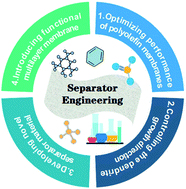A mini-review of advanced separator engineering in lithium metal batteries
Abstract
The lithium metal anode has been treated as the most promising alternative in next-generation lithium-based batteries due to its ultra-high theoretical capacity, low potential and light weight. However, significant challenges such as dendrite growth and poor lifetime have severely hindered the commercialization process of lithium metal anodes. The separator not only functions as the first signal of lithium dendrite formation, but also the last barrier to prevent the battery from short-circuit, playing an irreplaceable role in lithium metal batteries. Traditional polyolefin separators have shortcomings such as poor thermal stability and poor wettability. Therefore, separator engineering is of great significance for suppressing lithium dendrite growth. In this review, we classified the recent progress of separator engineering in lithium metal batteries into four parts: (1) optimizing the performance of polyolefin membranes; (2) controlling the dendrite growth direction; (3) developing a novel separator material; (4) introducing a functional multilayer membrane. To obtain direct evidence of dendrite suppression by separator engineering, new technical means for certifying lithium deposition behaviors have also been reviewed. Finally, our conclusion and perspectives on the future research and development of lithium metal batteries are also briefly outlined.

- This article is part of the themed collection: Sustainable Energy and Fuels Recent Review Articles


 Please wait while we load your content...
Please wait while we load your content...